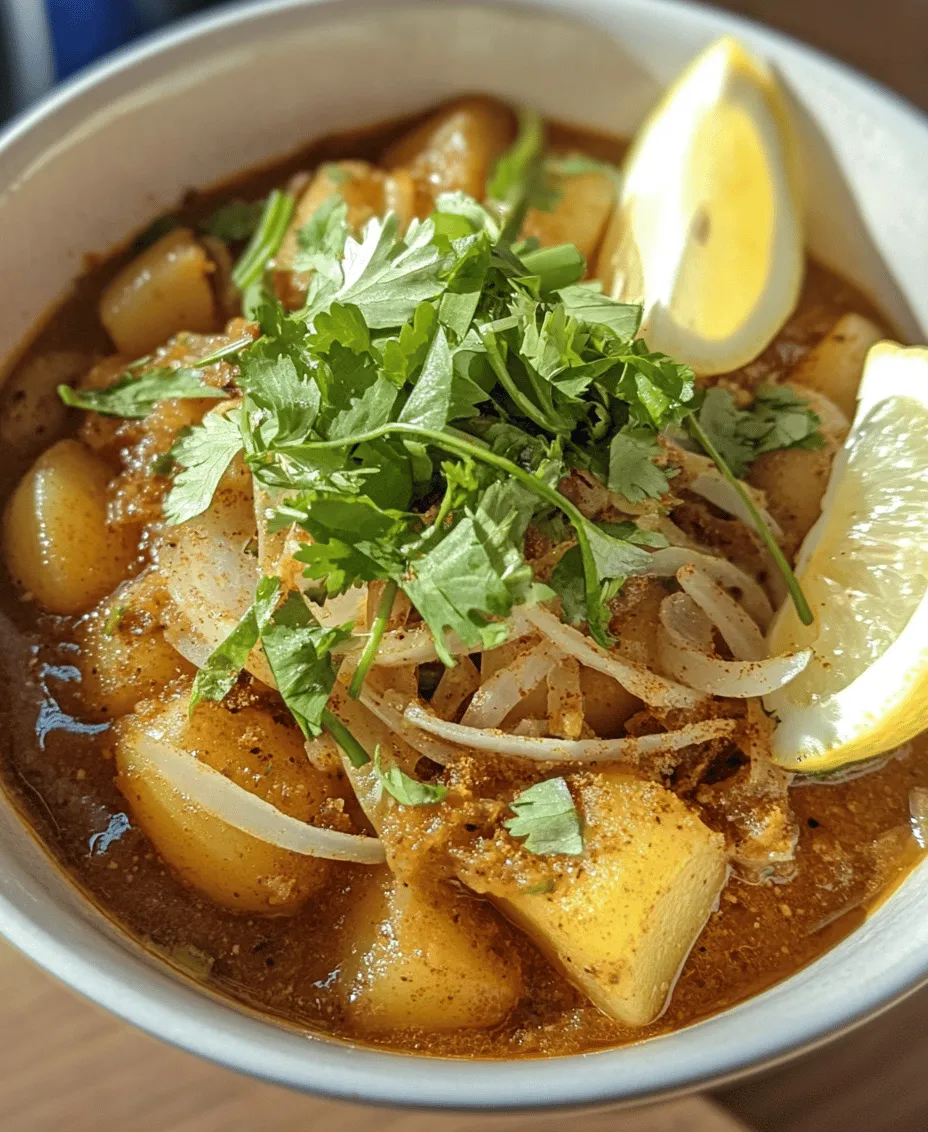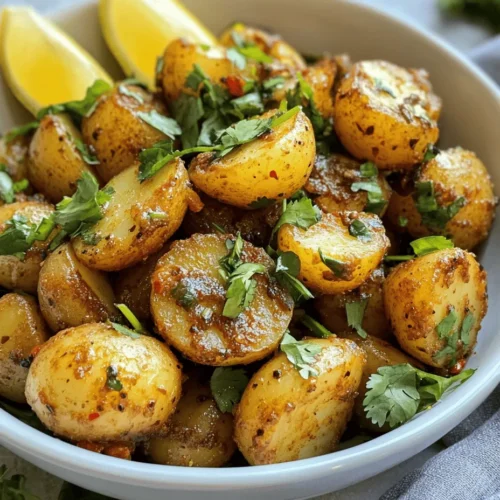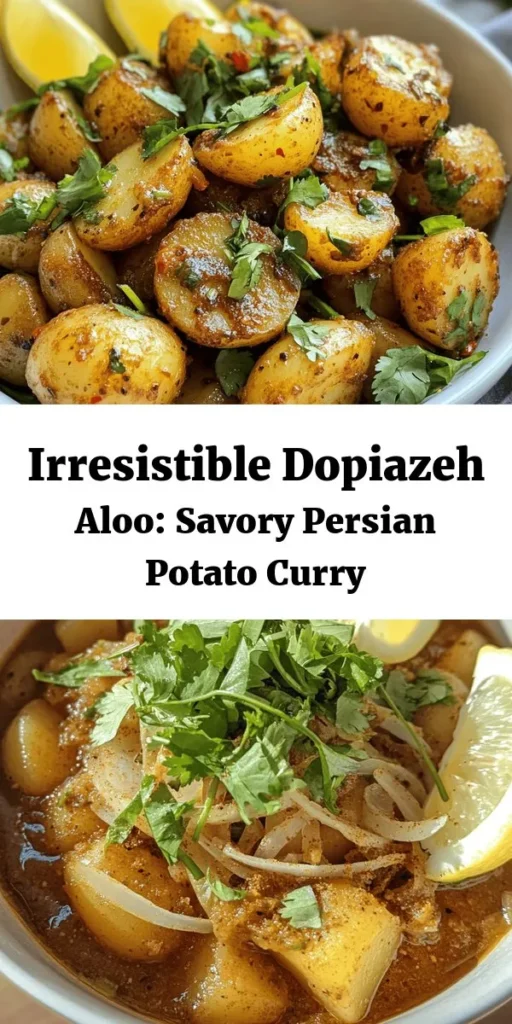Introduction
Persian cuisine is a tapestry of rich flavors, vibrant colors, and aromatic spices that tell the story of its cultural heritage. Renowned for its diverse range of dishes, Persian cooking often combines fragrant herbs, fresh ingredients, and a variety of cooking techniques that result in a gastronomic experience unlike any other. Among the many delightful offerings of this cuisine is Dopiazeh Aloo, a comforting and traditional dish that showcases the humble potato in a way that is both satisfying and flavorful.
Dopiazeh Aloo, which translates to “double onion potatoes,” is a beloved curry that highlights the versatility of potatoes in Persian cooking. Potatoes are not just a staple ingredient; they symbolize comfort and are often used in various dishes to create warmth and familiarity. This recipe is particularly special because it emphasizes the importance of onions—used in abundance—to enhance the overall flavor profile of the dish.
In this article, you can expect to dive deep into the world of Dopiazeh Aloo, exploring its origins, cultural significance, and the key ingredients that make it a standout dish. We’ll also provide a comprehensive step-by-step cooking method to guide you through the preparation, ensuring that you can recreate this delicious curry in your own kitchen.
Understanding Dopiazeh Aloo
Dopiazeh Aloo is more than just a potato curry; it is a dish steeped in tradition and history. With roots tracing back to the Persian Empire, this dish has evolved over centuries, adapting to regional tastes and ingredient availability. The term “Dopiazeh” refers to the use of two types of onions in the recipe—one sautéed to perfection and the other added later to maintain its crunch and flavor. This technique not only elevates the taste but also adds texture to the dish, making it a delightful experience for the palate.
Culturally, Dopiazeh Aloo holds a significant place in Persian households. It is often prepared for family gatherings, celebrations, and special occasions, embodying the spirit of hospitality that is central to Persian culture. This dish is typically served alongside fluffy basmati rice, creating a comforting meal that brings loved ones together around the table. Its rich, savory taste and aromatic spices make it a favorite among both Persian families and those new to the cuisine.
What sets Dopiazeh Aloo apart from other potato curries is not just its unique onion preparation but also the careful selection of spices that infuse the dish with depth and complexity. While many curries may rely heavily on cream or tomatoes for flavor, Dopiazeh Aloo achieves its savory richness through the careful balance of spices and the natural sweetness of the onions and potatoes.
Ingredients Breakdown
To create an authentic Dopiazeh Aloo, it is essential to understand each ingredient and its role in the dish. Below, we break down the key components that contribute to the delightful flavors and textures of this Persian potato curry.
Potatoes
Potatoes are the star ingredient of Dopiazeh Aloo. While there are various types of potatoes available, it is best to choose starchy varieties such as Yukon Gold or Russet for this recipe. These types hold their shape well during cooking and absorb the spices beautifully, resulting in tender, flavorful bites. The versatility of potatoes allows them to complement a wide range of spices, making them an ideal base for this curry.
Onions
In Dopiazeh Aloo, onions play a crucial role, both in terms of flavor and texture. The dish traditionally uses two kinds of onions: one that is sautéed until caramelized, and another that is added later for a fresh crunch. The caramelization process intensifies the natural sweetness of the onions, providing a rich foundation for the curry. It’s important to take your time with this step, as the depth of flavor it adds is significant.
Spices
Spices are the heart of any great curry, and Dopiazeh Aloo is no exception. A balanced blend of spices is critical in achieving the desired flavor profile. Here are the key spices used in this recipe:
– Cumin: Known for its warm, earthy aroma, cumin adds depth and a hint of nuttiness to the dish. It complements the sweetness of the onions and the creaminess of the potatoes.
– Coriander: With its citrusy notes, coriander brightens the dish and enhances the overall flavor. It pairs beautifully with cumin, providing a well-rounded spice blend.
– Turmeric: This vibrant yellow spice not only adds color but also contributes an earthy flavor and health benefits. Its anti-inflammatory properties make it a popular choice in many dishes.
– Garam Masala: A fragrant mix of spices, garam masala adds warmth and complexity. It typically includes cardamom, cinnamon, and cloves, making it a key element in achieving the signature taste of Dopiazeh Aloo.
Green Chilies
To adjust the spice level of Dopiazeh Aloo, green chilies are incorporated into the recipe. Depending on your preference, you can choose to increase or decrease the number of chilies used. For a milder flavor, consider using just one, while a spicier version can include more. The green chilies add a pleasant heat that balances the sweetness of the onions and the richness of the spices.
Tomato Paste
Tomato paste is added to Dopiazeh Aloo to provide depth and richness. It acts as a natural thickener and infuses the dish with a slightly tangy flavor that complements the potatoes and spices. The addition of tomato paste is crucial, as it enhances the overall taste and creates a harmonious blend of flavors.
Fresh Coriander Leaves and Lemon Wedges
To finish off Dopiazeh Aloo, fresh coriander leaves are used as a garnish, adding a burst of freshness and color. The bright green leaves not only enhance the visual appeal of the dish but also provide a herbal note that balances the richness of the curry. Additionally, serving the dish with lemon wedges allows diners to add a splash of acidity, brightening the flavors and elevating the overall experience.
Cooking Method
Now that we have explored the ingredients, let’s delve into the step-by-step process of preparing Dopiazeh Aloo. This recipe is designed to guide you through each stage, ensuring that you achieve the perfect balance of flavors and textures.
Step 1: Preparing the Ingredients
Start by gathering all your ingredients. As with any successful recipe, having everything prepped and ready to go is essential for a smooth cooking experience. Begin by peeling the potatoes and cutting them into even-sized cubes. This will ensure they cook uniformly.
Next, slice the onions thinly, keeping in mind that you will be using them in two different stages of the cooking process. If you prefer a bit of heat, you can also slice the green chilies at this point, adjusting the quantity based on your spice tolerance.
Step 2: Sautéing the Onions
In a large, heavy-bottomed pan or pot, heat some oil over medium heat. Once the oil is hot, add the sliced onions and a pinch of salt. The salt will help draw out moisture from the onions, allowing them to caramelize more effectively. Stir the onions frequently and be patient; this step can take around 15-20 minutes. You want the onions to turn golden brown and develop a sweet, caramelized flavor.
Step 3: Balancing the Spices
Once the onions are caramelized, it’s time to add the spices. Start with the cumin and coriander, stirring them in to release their aromatic oils. Then add the turmeric and garam masala, allowing them to toast for a minute or two. This process enhances the flavors, making them more vibrant. Be careful not to burn the spices, as this can lead to bitterness.
Step 4: Adding the Potatoes and Tomato Paste
When your spices are fragrant, add the cubed potatoes to the pot, stirring to coat them in the onion and spice mixture. Allow the potatoes to cook for a few minutes, letting them absorb the flavors. Following this, add the tomato paste, stirring well to combine all the ingredients. The tomato paste will create a cohesive sauce that envelops the potatoes, enriching the dish.
Step 5: Incorporating Water and Simmering
After the potatoes and tomato paste are well combined, pour in enough water to cover the potatoes. Increase the heat to bring the mixture to a gentle boil, then reduce it to low and cover the pot. Allow the Dopiazeh Aloo to simmer for about 20-25 minutes, or until the potatoes are tender and cooked through. Stir occasionally to ensure nothing sticks to the bottom of the pot.
Step 6: Finishing Touches
As the curry simmers, taste and adjust the seasoning as necessary, adding salt or additional spices to suit your preference. In the final moments of cooking, add the sliced green chilies and the second batch of sliced onions. This will add a fresh crunch to the dish, enhancing its texture and flavor.
Once the potatoes are tender, and the flavors have melded beautifully, remove the pot from the heat. Garnish the Dopiazeh Aloo with fresh coriander leaves and serve it hot with fluffy basmati rice or warm bread.
In the next part of this article, we will delve deeper into some tips for achieving the best results, common questions regarding Dopiazeh Aloo, and additional insights into serving this delightful dish. Stay tuned for more culinary exploration!

Simmering is a crucial step in preparing Dopiazeh Aloo, as it significantly impacts both the texture and taste of this delightful Persian potato curry. During the simmering process, the ingredients meld together, allowing the spices to infuse deeply into the potatoes and onions. This slow cooking method ensures that the potatoes become tender while absorbing the aromatic flavors from the spices. Additionally, simmering helps thicken the curry, creating a luscious sauce that clings to the potatoes perfectly.
After cooking, it’s essential to allow the Dopiazeh Aloo to rest for a while. This resting period is not merely a waiting game; it is an integral part of the cooking process. As the curry cools slightly, the flavors continue to develop and meld, enhancing the overall taste. This is particularly important for dishes like Dopiazeh Aloo, where the complexity of flavors from various spices and ingredients can truly shine through after some time. Aim for at least 10 to 15 minutes of resting before serving, allowing the dish to reach its full potential.
Nutritional Aspects of Dopiazeh Aloo
When it comes to nutrition, Dopiazeh Aloo offers not only a hearty meal but also a wealth of health benefits. Each serving typically contains around 250-300 calories, depending on the portion size and specific ingredients used. This makes it a relatively light yet filling dish, perfect for a satisfying lunch or dinner.
The primary ingredients in Dopiazeh Aloo—potatoes, onions, and an array of spices—contribute to its nutritional profile. Potatoes are rich in carbohydrates, providing a good source of energy along with essential vitamins such as vitamin C and B6. They also contain dietary fiber, which aids in digestion. Onions, a staple in many cuisines, are low in calories but high in antioxidants and flavonoids, which may contribute to heart health and have anti-inflammatory properties. The spices used in Dopiazeh Aloo, such as turmeric and cumin, not only enhance flavor but also provide various health benefits, including anti-inflammatory effects and improved digestion.
This dish is naturally vegetarian and vegan-friendly, making it an excellent choice for those following plant-based diets. It can easily accommodate various dietary preferences, ensuring that everyone at the table can enjoy its flavors without compromise.
When it comes to portion sizes, a standard serving of Dopiazeh Aloo is about one cup, which pairs well with traditional accompaniments. This allows you to enjoy the dish without overwhelming your plate, leaving room for sides that complement its flavors.
Serving Suggestions
Dopiazeh Aloo shines brightest when served with traditional Persian accompaniments. A warm, fluffy flatbread, such as lavash or naan, is perfect for scooping up the curry and soaking up the delicious sauce. Alternatively, a serving of fragrant steamed basmati rice enhances the meal, providing a neutral base that balances the rich flavors of the curry. For added freshness, consider serving the dish alongside a simple salad of diced cucumbers, tomatoes, and herbs, dressed with lemon juice and olive oil.
For those looking to get a bit creative, there are numerous ways to serve Dopiazeh Aloo. You could turn it into a hearty wrap by placing a generous scoop of the curry in a flatbread, adding some fresh herbs and a drizzle of yogurt or tahini sauce for extra flavor. Another option is to present it as part of a larger Persian feast, alongside other dishes like saffron rice, grilled vegetables, or even a refreshing yogurt dip.
Beverage pairings can elevate your Dopiazeh Aloo experience. A chilled glass of doogh, a traditional Persian yogurt drink, complements the spices perfectly and adds a refreshing contrast to the warmth of the curry. If you prefer something non-alcoholic, a lightly brewed mint tea or a tangy pomegranate juice can also enhance the meal. For those who enjoy wine, a light, fruity white wine can balance the dish’s richness.
Variations and Adaptations
Exploring the regional variations of Dopiazeh Aloo across Persia can lead to exciting culinary discoveries. In some regions, you may find versions that incorporate additional vegetables, such as carrots or bell peppers, which add depth of flavor and color. Others might use different spices or cooking techniques, reflecting local tastes and traditions.
If you’re looking to accommodate dietary restrictions, consider substituting ingredients. For a gluten-free option, ensure that any flatbreads or side dishes are made without gluten. You can also experiment with different types of potatoes, such as sweet potatoes for a unique twist, or use a variety of spices to create a flavor profile that suits your palate.
For those wishing to add protein to the dish, consider incorporating chickpeas, which meld beautifully with the flavors of the curry and add a hearty texture. If meat is a preferred option, diced chicken or lamb can be sautéed with the onions before adding the potatoes, providing a satisfying variation that still respects the essence of Dopiazeh Aloo.
Storing and Reheating Dopiazeh Aloo
To maintain the deliciousness of your Dopiazeh Aloo, proper storage is key. Allow the curry to cool completely before transferring it to an airtight container. It can be stored in the refrigerator for up to four days, making it an ideal dish for meal prep. If you find yourself with leftovers, you can also freeze the curry for up to three months. Just ensure it’s in a freezer-safe container, and label it with the date for future reference.
When it comes time to reheat, the goal is to maintain the flavor and texture of the dish. Gently reheat Dopiazeh Aloo on the stovetop over low heat, adding a splash of water or vegetable broth if necessary to prevent it from drying out. Stir occasionally to ensure even heating. If reheating in the microwave, do so in short intervals, stirring in between, to ensure the curry heats evenly without becoming rubbery.
If you’ve frozen the curry, thaw it in the refrigerator overnight before reheating. This gradual thawing helps retain the integrity of the potatoes and spices, ensuring that your Dopiazeh Aloo remains as delightful as when it was first made.
Conclusion
Dopiazeh Aloo is more than just a delicious potato curry; it is a reflection of Persian culinary tradition and culture. The combination of tender potatoes, caramelized onions, and aromatic spices creates a dish that is both comforting and complex, making it a perfect centerpiece for any meal. Its versatility allows for personalization, whether you’re sticking to traditional recipes or experimenting with new flavors.
By preparing Dopiazeh Aloo at home, you not only indulge in the rich flavors of Persian cuisine but also embrace the joy of cooking and sharing meals with loved ones. The heartwarming experience of serving this curry to family and friends, along with its beautiful presentation, brings people together around the table. So why not give this flavorful dish a try? Dive into the world of Persian cooking, and let Dopiazeh Aloo bring a taste of the exotic to your kitchen.



